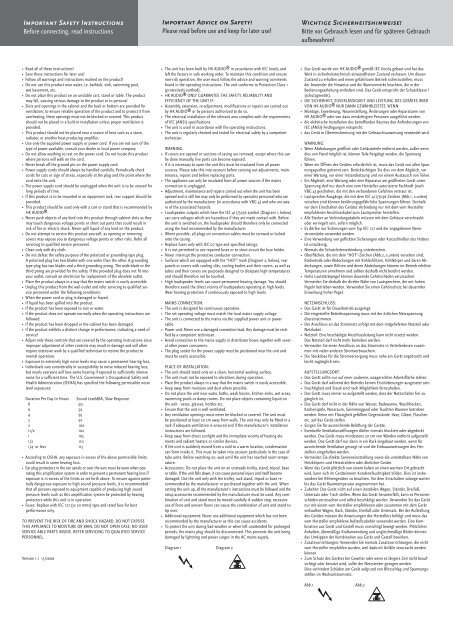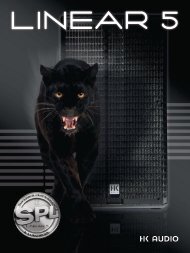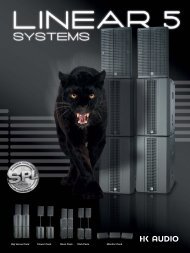Manual 1.1 - LIVEAUDIO.ro
Manual 1.1 - LIVEAUDIO.ro
Manual 1.1 - LIVEAUDIO.ro
Create successful ePaper yourself
Turn your PDF publications into a flip-book with our unique Google optimized e-Paper software.
Important Safety Instructions<br />
Before connecting, read instructions<br />
Important Advice on Safety!<br />
Please read before use and keep for later use!<br />
Wichtige Sicherheitshinweise!<br />
Bitte vor Gebrauch lesen und für späteren Gebrauch<br />
aufbewahren!<br />
• Read all of these instructions!<br />
• Save these instructions for later use!<br />
• Follow all warnings and instructions marked on the p<strong>ro</strong>duct!<br />
• Do not use this p<strong>ro</strong>duct near water, i.e. bathtub, sink, swimming pool,<br />
wet basement, etc.<br />
• Do not place this p<strong>ro</strong>duct on an unstable cart, stand or table. The p<strong>ro</strong>duct<br />
may fall, causing serious damage to the p<strong>ro</strong>duct or to persons!<br />
• Slots and openings in the cabinet and the back or bottom are p<strong>ro</strong>vided for<br />
ventilation; to ensure reliable operation of the p<strong>ro</strong>duct and to p<strong>ro</strong>tect it f<strong>ro</strong>m<br />
overheating, these openings must not be blocked or covered. This p<strong>ro</strong>duct<br />
should not be placed in a built-in installation unless p<strong>ro</strong>per ventilation is<br />
p<strong>ro</strong>vided.<br />
• This p<strong>ro</strong>duct should not be placed near a source of heat such as a stove,<br />
radiator, or another heat p<strong>ro</strong>ducing amplifier.<br />
• Use only the supplied power supply or power cord. If you are not sure of the<br />
type of power available, consult your dealer or local power company.<br />
• Do not allow anything to rest on the power cord. Do not locate this p<strong>ro</strong>duct<br />
where persons will walk on the cord.<br />
• Never break off the g<strong>ro</strong>und pin on the power supply cord.<br />
• Power supply cords should always be handled carefully. Periodically check<br />
cords for cuts or sign of stress, especially at the plug and the point where the<br />
cord exits the unit.<br />
• The power supply cord should be unplugged when the unit is to be unused for<br />
long periods of time.<br />
• If this p<strong>ro</strong>duct is to be mounted in an equipment rack, rear support should be<br />
p<strong>ro</strong>vided.<br />
• This p<strong>ro</strong>duct should be used only with a cart or stand that is recommended by<br />
HK AUDIO ® .<br />
• Never push objects of any kind into this p<strong>ro</strong>duct th<strong>ro</strong>ugh cabinet slots as they<br />
may touch dange<strong>ro</strong>us voltage points or short out parts that could result in<br />
risk of fire or electric shock. Never spill liquid of any kind on the p<strong>ro</strong>duct.<br />
• Do not attempt to service this p<strong>ro</strong>duct yourself, as opening or removing<br />
covers may expose you to dange<strong>ro</strong>us voltage points or other risks. Refer all<br />
servicing to qualified service personnel.<br />
• Clean only with dry cloth.<br />
• Do not defeat the safety purpose of the polarized or g<strong>ro</strong>unding-type plug.<br />
A polarized plug has two blades with one wider than the other. A g<strong>ro</strong>unding<br />
type plug has two blades and a third g<strong>ro</strong>unding p<strong>ro</strong>ng. The wide blade or the<br />
third p<strong>ro</strong>ng are p<strong>ro</strong>vided for the safety. If the p<strong>ro</strong>vided plug does not fit into<br />
your outlet, consult an electrician for replacement of the obsolete outlet.<br />
• Place the p<strong>ro</strong>duct always in a way that the mains switch is easily accessible.<br />
• Unplug this p<strong>ro</strong>duct f<strong>ro</strong>m the wall outlet and refer servicing to qualified service<br />
personnel under the following conditions:<br />
• When the power cord or plug is damaged or frayed.<br />
• If liquid has been spilled into the p<strong>ro</strong>duct.<br />
• If the p<strong>ro</strong>duct has been exposed to rain or water.<br />
• If the p<strong>ro</strong>duct does not operate normally when the operating instructions are<br />
followed.<br />
• If the p<strong>ro</strong>duct has been d<strong>ro</strong>pped or the cabinet has been damaged.<br />
• If the p<strong>ro</strong>duct exhibits a distinct change in performance, indicating a need of<br />
service!<br />
• Adjust only these cont<strong>ro</strong>ls that are covered by the operating instructions since<br />
imp<strong>ro</strong>per adjustment of other cont<strong>ro</strong>ls may result in damage and will often<br />
require extensive work by a qualified technician to restore the p<strong>ro</strong>duct to<br />
normal operation.<br />
• Exposure to extremely high noise levels may cause a permanent hearing loss.<br />
• Individuals vary considerably in susceptibility to noise induced hearing loss,<br />
but nearly everyone will lose some hearing if exposed to sufficiently intense<br />
noise for a sufficient time. The U.S. Government´s Occupational Safety and<br />
Health Administration (OSHA) has specified the following permissible noise<br />
level exposures:<br />
Duration Per Day In Hours Sound LeveldBA, Slow Response<br />
8 90<br />
6 92<br />
4 95<br />
3 97<br />
2 100<br />
11/2 102<br />
1 105<br />
1/2 110<br />
1/4 or less 115<br />
• According to OSHA, any exposure in excess of the above permissible limits<br />
could result in some hearing loss.<br />
• Ear plug p<strong>ro</strong>tectors in the ear canals or over the ears must be worn when operating<br />
this amplification system in order to prevent a permanent hearing loss if<br />
exposure is in excess of the limits as set forth above. To ensure against potentially<br />
dange<strong>ro</strong>us exposure to high sound pressure levels, it is recommended<br />
that all persons exposed to equipment capable of p<strong>ro</strong>ducing high sound<br />
pressure levels such as this amplification system be p<strong>ro</strong>tected by hearing<br />
p<strong>ro</strong>tectors while this unit is in operation.<br />
• Fuses: Replace with IEC 127 (5x 20 mms) type and rated fuse for best<br />
performance only.<br />
TO PREVENT THE RISK OF FIRE AND SHOCK HAZARD, DO NOT EXPOSE<br />
THIS APPLIANCE TO MOISTURE OR RAIN. DO NOT OPEN CASE; NO USER<br />
SERVICE-ABLE PARTS INSIDE. REFER SERVICING TO QUALIFIED SERVICE<br />
PERSONNEL.<br />
Version <st<strong>ro</strong>ng>1.1</st<strong>ro</strong>ng> 11/2006<br />
• The unit has been built by HK AUDIO ® in accordance with IEC 60065 and<br />
left the factory in safe working order. To maintain this condition and ensure<br />
non-risk operation, the user must follow the advice and warning comments<br />
found in the operating instructions. The unit conforms to P<strong>ro</strong>tection Class 1<br />
(p<strong>ro</strong>tectively earthed).<br />
• HK AUDIO ® ONLY GUARANTEE THE SAFETY, RELIABILITY AND<br />
EFFICIENCY OF THE UNIT IF:<br />
• Assembly, extension, re-adjustment, modifications or repairs are carried out<br />
by HK AUDIO ® or by persons authorized to do so.<br />
• The electrical installation of the relevant area complies with the requirements<br />
of IEC (ANSI) specifications.<br />
• The unit is used in accordance with the operating instructions.<br />
• The unit is regularly checked and tested for electrical safety by a competent<br />
technician.<br />
WARNING:<br />
• If covers are opened or sections of casing are removed, except where this can<br />
be done manually, live parts can become exposed.<br />
• If it is necessary to open the unit this must be insulated f<strong>ro</strong>m all power<br />
sources. Please take this into account before carrying out adjustments, maintenance,<br />
repairs and before replacing parts.<br />
• The appliance can only be insulated f<strong>ro</strong>m all power sources if the mains<br />
connection is unplugged.<br />
• Adjustment, maintenance and repairs carried out when the unit has been<br />
opened and is still live may only be performed by specialist personnel who are<br />
authorized by the manufacturer (in accordance with VBG 4) and who are aware<br />
of the associated hazards.<br />
• Loudspeaker outputs which have the IEC 417/5036 symbol (Diagram 1, below)<br />
can carry voltages which are hazardous if they are made contact with. Before<br />
the unit is switched on, the loudspeaker should therefore only be connected<br />
using the lead recommended by the manufacturer.<br />
• Where possible, all plugs on connection cables must be screwed or locked<br />
onto the casing.<br />
• Replace fuses only with IEC127 type and specified ratings.<br />
• It is not permitted to use repaired fuses or to short-circuit the fuse holder.<br />
• Never interrupt the p<strong>ro</strong>tective conductor connection.<br />
• Surfaces which are equipped with the "HOT" mark (Diagram 2, below), rear<br />
panels or covers with cooling slits, cooling bodies and their covers, as well as<br />
tubes and their covers are purposely designed to dissipate high temperatures<br />
and should therefore not be touched.<br />
• High loudspeaker levels can cause permanent hearing damage. You should<br />
therefore avoid the direct vicinity of loudspeakers operating at high levels.<br />
Wear hearing p<strong>ro</strong>tection if continuously exposed to high levels.<br />
MAINS CONNECTION:<br />
• The unit is designed for continuous operation.<br />
• The set operating voltage must match the local mains supply voltage.<br />
• The unit is connected to the mains via the supplied power unit or power<br />
cable.<br />
• Power unit: Never use a damaged connection lead. Any damage must be rectified<br />
by a competent technician.<br />
• Avoid connection to the mains supply in distributor boxes together with several<br />
other power consumers.<br />
• The plug socket for the power supply must be positioned near the unit and<br />
must be easily accessible.<br />
PLACE OF INSTALLATION:<br />
• The unit should stand only on a clean, horizontal working surface.<br />
• The unit must not be exposed to vibrations during operation.<br />
• Place the p<strong>ro</strong>duct always in a way that the mains switch is easily accessible.<br />
• Keep away f<strong>ro</strong>m moisture and dust where possible.<br />
• Do not place the unit near water, baths, wash basins, kitchen sinks, wet areas,<br />
swimming pools or damp <strong>ro</strong>oms. Do not place objects containing liquid on<br />
the unit - vases, glasses, bottles etc.<br />
• Ensure that the unit is well ventilated.<br />
• Any ventilation openings must never be blocked or covered. The unit must<br />
be positioned at least 20 cm away f<strong>ro</strong>m walls. The unit may only be fitted in a<br />
rack if adequate ventilation is ensured and if the manufacturer's installation<br />
instructions are followed.<br />
• Keep away f<strong>ro</strong>m direct sunlight and the immediate vicinity of heating elements<br />
and radiant heaters or similar devices.<br />
• If the unit is suddenly moved f<strong>ro</strong>m a cold to a warm location, condensation<br />
can form inside it. This must be taken into account particularly in the case of<br />
tube units. Before switching on, wait until the unit has reached <strong>ro</strong>om temperature.<br />
• Accessories: Do not place the unit on an unsteady t<strong>ro</strong>lley, stand, tripod, base<br />
or table. If the unit falls down, it can cause personal injury and itself become<br />
damaged. Use the unit only with the t<strong>ro</strong>lley, rack stand, tripod or base recommended<br />
by the manufacturer or purchased together with the unit. When<br />
setting the unit up, all the manufacturer's instructions must be followed and the<br />
setup accessories recommended by the manufacturer must be used. Any combination<br />
of unit and stand must be moved carefully. A sudden stop, excessive<br />
use of force and uneven floors can cause the combination of unit and stand to<br />
tip over.<br />
• Additional equipment: Never use additional equipment which has not been<br />
recommended by the manufacturer as this can cause accidents.<br />
• To p<strong>ro</strong>tect the unit during bad weather or when left unattended for p<strong>ro</strong>longed<br />
periods, the mains plug should be disconnected. This prevents the unit being<br />
damaged by lightning and power surges in the AC mains supply.<br />
Diagram 1 Diagram 2<br />
• Das Gerät wurde von HK AUDIO ® gemäß IEC 60065 gebaut und hat das<br />
Werk in sicherheitstechnisch einwandfreiem Zustand verlassen. Um diesen<br />
Zustand zu erhalten und einen gefahrlosen Betrieb sicherzustellen, muss<br />
der Anwender die Hinweise und die Warnvermerke beachten, die in der<br />
Bedienungsanleitung enthalten sind. Das Gerät entspricht der Schutzklasse I<br />
(schutzgeerdet).<br />
• DIE SICHERHEIT, ZUVERLÄSSIGKEIT UND LEISTUNG DES GERÄTES WIRD<br />
VON HK AUDIO ® NUR DANN GEWÄHRLEISTET, WENN:<br />
• Montage, Erweiterung, Neueinstellung, Änderungen oder Reparaturen von<br />
HK AUDIO ® oder von dazu ermächtigten Personen ausgeführt werden.<br />
• die elektrische Installation des betreffenden Raumes den Anforderungen von<br />
IEC (ANSI)-Festlegungen entspricht.<br />
• das Gerät in Übereinstimmung mit der Gebrauchsanweisung verwendet wird.<br />
WARNUNG:<br />
• Wenn Abdeckungen geöffnet oder Gehäuseteile entfernt werden, außer wenn<br />
dies von Hand möglich ist, können Teile freigelegt werden, die Spannung<br />
führen.<br />
• Wenn ein Öffnen des Gerätes erforderlich ist, muss das Gerät von allen Spannungsquellen<br />
getrennt sein. Berücksichtigen Sie dies vor dem Abgleich, vor<br />
einer Wartung, vor einer Instandsetzung und vor einem Austausch von Teilen.<br />
• Ein Abgleich, eine Wartung oder eine Reparatur am geöffneten Gerät unter<br />
Spannung darf nur durch eine vom Hersteller autorisierte Fachkraft (nach<br />
VBG 4) geschehen, die mit den verbundenen Gefahren vertraut ist.<br />
• Lautsprecher-Ausgänge, die mit dem IEC 417/5036-Zeichen (Abb.1, s.unten)<br />
versehen sind können berührungsgefährliche Spannungen führen. Deshalb<br />
vor dem Einschalten des Gerätes Verbindung nur mit dem vom Hersteller<br />
empfohlenen Anschlusskabel zum Lautsprecher herstellen.<br />
• Alle Stecker an Verbindungskabeln müssen mit dem Gehäuse verschraubt<br />
oder verriegelt sein, sofern möglich.<br />
• Es dürfen nur Sicherungen vom Typ IEC 127 und der angegebenen Nennst<strong>ro</strong>mstärke<br />
verwendet werden.<br />
• Eine Verwendung von geflickten Sicherungen oder Kurzschließen des Halters<br />
ist unzulässig.<br />
• Niemals die Schutzleiterverbindung unterbrechen.<br />
• Oberflächen, die mit dem "HOT"-Zeichen (Abb.2, s.unten) versehen sind,<br />
Rückwände oder Abdeckungen mit Kühlschlitzen, Kühlkörper und deren Abdeckungen,<br />
sowie Röhren und deren Abdeckungen können im Betrieb erhöhte<br />
Temperaturen annehmen und sollten deshalb nicht berührt werden.<br />
• Hohe Lautstärkepegel können dauernde Gehörschäden verursachen.<br />
Vermeiden Sie deshalb die direkte Nähe von Lautsprechern, die mit hohen<br />
Pegeln betrieben werden. Verwenden Sie einen Gehörschutz bei dauernder<br />
Einwirkung hoher Pegel.<br />
NETZANSCHLUSS:<br />
• Das Gerät ist für Dauerbetrieb ausgelegt.<br />
• Die eingestellte Betriebsspannung muss mit der örtlichen Netzspannung<br />
übereinstimmen.<br />
• Der Anschluss an das St<strong>ro</strong>mnetz erfolgt mit dem mitgelieferten Netzteil oder<br />
Netzkabel.<br />
• Netzteil: Eine beschädigte Anschlussleitung kann nicht ersetzt werden.<br />
Das Netzteil darf nicht mehr betrieben werden.<br />
• Vermeiden Sie einen Anschluss an das St<strong>ro</strong>mnetz in Verteilerdosen zusammen<br />
mit vielen anderen St<strong>ro</strong>mverbrauchern.<br />
• Die Steckdose für die St<strong>ro</strong>mversorgung muss nahe am Gerät angebracht und<br />
leicht zugänglich sein.<br />
AUFSTELLUNGSORT:<br />
• Das Gerät sollte nur auf einer sauberen, waagerechten Arbeitsfläche stehen.<br />
• Das Gerät darf während des Betriebs keinen Erschütterungen ausgesetzt sein.<br />
• Feuchtigkeit und Staub sind nach Möglichkeit fernzuhalten.<br />
• Das Gerät muss immer so aufgestellt werden, dass der Netzschalter frei zugänglich<br />
ist.<br />
• Das Gerät darf nicht in der Nähe von Wasser, Badewanne, Waschbecken,<br />
Küchenspüle, Nassraum, Swimmingpool oder feuchten Räumen betrieben<br />
werden. Keine mit Flüssigkeit gefüllten Gegenstände -Vase, Gläser, Flaschen<br />
etc. auf das Gerät stellen.<br />
• Sorgen Sie für ausreichende Belüftung der Geräte.<br />
• Eventuelle Ventilationsöffnungen dürfen niemals blockiert oder abgedeckt<br />
werden. Das Gerät muss mindestens 20 cm von Wänden entfernt aufgestellt<br />
werden. Das Gerät darf nur dann in ein Rack eingebaut werden, wenn für<br />
ausreichende Ventilation gesorgt ist und die Einbauanweisungen des Herstellers<br />
eingehalten werden.<br />
• Vermeiden Sie direkte Sonneneinstrahlung sowie die unmittelbare Nähe von<br />
Heizkörpern und Heizstrahlern oder ähnlicher Geräte.<br />
• Wenn das Gerät plötzlich von einem kalten an einen warmen Ort gebracht<br />
wird, kann sich im Geräteinnern Kondensfeuchtigkeit bilden. Dies ist insbesondere<br />
bei Röhrengeräten zu beachten. Vor dem Einschalten solange warten<br />
bis das Gerät Raumtemperatur angenommen hat.<br />
• Zubehör: Das Gerät nicht auf einen instabilen Wagen, Ständer, Dreifuß,<br />
Untersatz oder Tisch stellen. Wenn das Gerät herunterfällt, kann es Personenschäden<br />
verursachen und selbst beschädigt werden. Verwenden Sie das Gerät<br />
nur mit einem vom Hersteller empfohlenen oder zusammen mit dem Gerät<br />
verkauften Wagen, Rack, Ständer, Dreifuß oder Untersatz. Bei der Aufstellung<br />
des Gerätes müssen die Anweisungen des Herstellers befolgt und muss das<br />
vom Hersteller empfohlene Aufstellzubehör verwendet werden. Eine Kombination<br />
aus Gerät und Gestell muss vorsichtigt bewegt werden. Plötzliches<br />
Anhalten, übermäßige Kraftanwendung und ungleichmäßige Böden können<br />
das Umkippen der Kombination aus Gerät und Gestell bewirken.<br />
• Zusatzvorrichtungen: Verwenden Sie niemals Zusatzvorrichtungen, die nicht<br />
vom Hersteller empfohlen wurden, weil dadurch Unfälle verursacht werden<br />
können<br />
• Zum Schutz des Gerätes bei Gewitter oder wenn es längere Zeit nicht beaufsichtigt<br />
oder benutzt wird, sollte der Netzstecker gezogen werden.<br />
Dies verhindert Schäden am Gerät aufgrund von Blitzschlag und Spannungsstößen<br />
im Wechselst<strong>ro</strong>mnetz.<br />
Abb.1<br />
Abb.2





